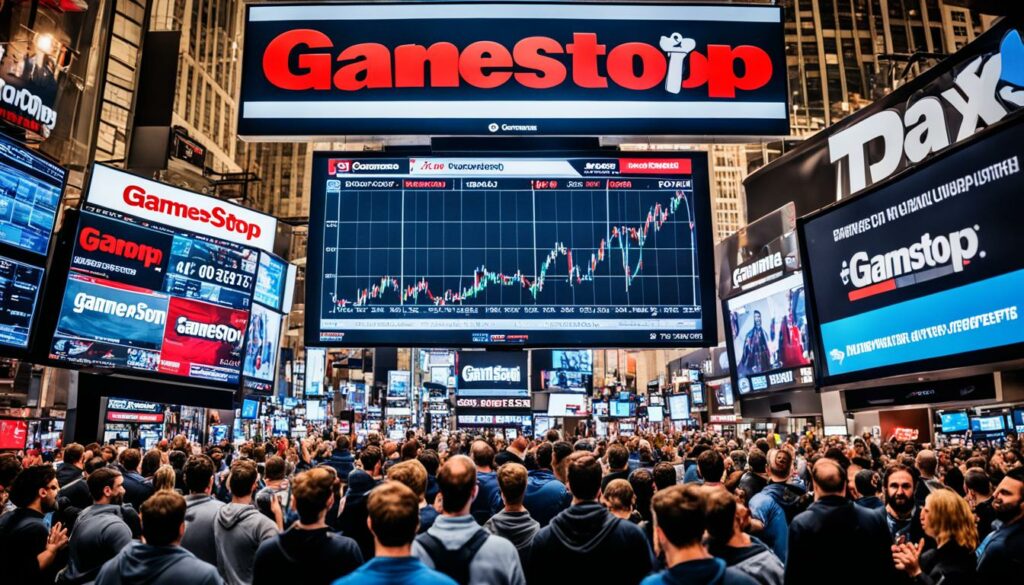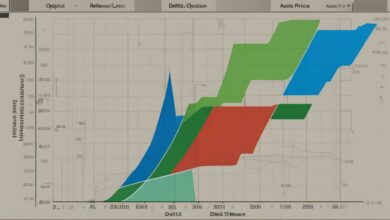What Is A Gamma Squeeze?

A gamma squeeze is a phenomenon that occurs in the stock market when there is a sudden increase in buying activity of short-dated call options for a particular stock. This surge in call buying leads to an upward spiral, with higher stock prices triggering more call buying and further driving up the stock prices. Gamma squeezes are often associated with options trading and can result in dramatic, sudden gains in stock prices. They can be risky for investors who do not fully understand how they work.
Key Takeaways:
- A gamma squeeze is a rapid increase in buying activity of short-dated call options for a specific stock.
- It leads to an upward spiral in stock prices as more call buying occurs.
- Gamma squeezes are associated with options trading and can result in significant gains.
- Investors need to understand the risks involved in gamma squeezes before participating.
- Timing is crucial in trading gamma squeezes, and risk management is essential.
Understanding Squeezes in the Stock Market
Squeezes in the stock market can occur when stock prices experience rapid shifts and investors find themselves buying or selling shares outside of their normal trading patterns.
A short squeeze is a specific type of squeeze where an increase in stock prices forces investors who have shorted the stock to buy back their shares. Shorting a stock means betting that its price will go down.
A gamma squeeze, on the other hand, is caused by widespread buying activity of short-dated call options and can lead to significant increases in stock prices.
Short squeezes and gamma squeezes can have a substantial impact on the stock market, affecting the fortunes of both individual investors and institutional traders.
To get a deeper understanding of these squeezes, let’s take a look at the mechanics behind them and the conditions that favor their occurrence.
The Mechanics behind a Gamma Squeeze
When it comes to understanding how a gamma squeeze works, it’s essential to familiarize yourself with the concept of gamma, one of the “Greeks” frequently used in options trading. Gamma measures the rate of change of an option’s price in response to changes in the underlying stock’s price.
Gamma is closely related to another Greek parameter called delta, which measures the rate of change of an option’s price based on changes in the stock’s price.
By utilizing gamma and delta, options traders can analyze stock price changes over time and make informed decisions about the appropriate strategies to employ in their trading activities.
Let’s take a closer look at the significance of gamma and how it relates to options trading and stock price movements:
The Importance of Gamma in Options Trading
“Gamma is crucial in options trading as it helps traders understand how the price of an option will respond to changes in the stock’s price.”
Gamma values can vary depending on the strike price and expiration date of the option. A high gamma indicates that the option’s price is more sensitive to changes in the stock’s price, while a low gamma suggests less sensitivity to price changes.
This knowledge is vital for traders as it allows them to predict the potential impact of stock price movements on the value of their options and adjust their trading strategies accordingly.
Gamma and Delta Relationship
“Delta and gamma are closely intertwined, as delta determines the rate of change of an option’s price, while gamma helps track the rate of change of delta itself.”
Delta is calculated as the ratio between the change in the option’s price and the corresponding change in the stock’s price. Gamma, in turn, measures the change in delta for a given change in the stock’s price.
Both gamma and delta contribute valuable insights into the relationship between changes in stock prices and the behavior of options prices, enabling traders to make well-informed decisions.
| Gamma | Delta |
|---|---|
| Measures the rate of change of an option’s price in response to changes in the stock’s price. | Measures the rate of change of an option’s price based on changes in the stock’s price. |
| Helps traders predict the impact of stock price movements on options’ values. | Assists in determining the rate of change between the option’s price and the stock’s price. |
Utilizing gamma and delta effectively can greatly enhance a trader’s ability to respond to stock price fluctuations and optimize their options trading strategies. It is essential to have a comprehensive understanding of these concepts when engaging in options trading.

Conditions for a Gamma Squeeze
For a gamma squeeze to occur, several conditions need to be met. It all starts with investors making assumptions about the future price movement of a specific stock, anticipating an increase. This assumption leads to widespread buying of short-dated call options for the stock. As the stock’s price rises, the value of these call options increases as well.
When institutional investors, who sold these call options, find themselves in a short position due to the rising stock price, they must buy shares of the stock to hedge against their short position. This buying activity further drives up the stock prices.
As more money flows into call options, it can trigger more buying activity, creating a positive feedback loop and resulting in higher stock prices. This chain of events leads to a phenomenon known as a gamma squeeze.
To summarize, the conditions necessary for a gamma squeeze include:
- Investors making assumptions about a stock’s price increase
- Widespread buying of short-dated call options
- Institutional investors finding themselves in a short position
- Institutional investors buying shares of the stock to hedge
- More buying activity and increasing stock prices
Overall, a gamma squeeze occurs when assumptions, call options, institutional investors, hedging, and short positions align, resulting in a surge in stock prices.

Examples of Gamma Squeezes
Gamma squeezes have occurred in various instances, with two notable examples being AMC Entertainment and GameStop. These events garnered significant attention and resulted in unprecedented stock price surges.
AMC Entertainment
In June 2021, AMC Entertainment, the American movie theater chain, experienced a gamma squeeze that captured the interest of market participants. Retail investors, collectively known as the “apes,” coordinated through social media platforms to drive up the stock’s price. They were motivated by a mix of market speculation, a desire to challenge short positions held by institutional investors and hedge funds, and a sense of unity among retail investors on a mission to defy Wall Street conventions.

GameStop
Another notable gamma squeeze occurred in early 2021 with GameStop, a video game retailer. The squeeze was initiated by a Reddit group called r/wallstreetbets. They pooled their buying power to target GameStop’s stock, squeezing out institutional investors who held substantial short positions. This remarkable campaign led to a meteoric rise in GameStop’s stock price, capturing global attention and challenging traditional market dynamics.

Comparing AMC and GameStop Gamma Squeezes
| Factors | AMC Entertainment Gamma Squeeze | GameStop Gamma Squeeze |
|---|---|---|
| Main Catalyst | Retail investor coordination and market speculation | Reddit group r/wallstreetbets instigating a short squeeze |
| Impact on Stock Price | Significant increase | Meteoric rise |
| Duration | June 2021 | Early 2021 |
| Participants | Retail investors driven by social media coordination | Reddit group challenging institutional investors |
| Market Attention | Global media coverage | Global media coverage |
These examples highlight the power of coordinated actions by retail investors, showcasing how market dynamics can be influenced by emerging market forces and challenging traditional notions of stock valuation and trading.
Risks and Opportunities of Gamma Squeezes
Gamma squeezes in options trading can offer both profitable opportunities and potential risks for traders. By understanding the timing and dynamics of a gamma squeeze, traders can make informed decisions to maximize their profit potential while managing the associated risks.
During a gamma squeeze, traders who have purchased call options at the right timing can capitalize on the surge in stock prices. Selling these call options at high prices can lead to substantial profits. However, it is crucial to note that gamma squeezes can be short-lived. If traders fail to sell their call options at the peak of the squeeze, the stock prices can quickly decline, resulting in potential losses.
Engaging in options trading, including participating in gamma squeezes, carries more risk compared to other forms of trading such as stocks, mutual funds, or ETFs. It is important for traders to assess their risk tolerance before venturing into options trading. Understanding the potential for gains and losses and setting realistic expectations is key to managing risks effectively.
To mitigate the risks associated with gamma squeezes, traders should consider consulting a financial advisor. Financial advisors can offer valuable insights and guide traders in developing a risk management strategy that aligns with their individual goals and risk tolerance. Their expertise can help traders navigate the complexities of options trading and make informed decisions to optimize their returns.

When participating in a gamma squeeze or any options trading activity, traders must carefully consider the timing of their trades, the potential for gains, and the level of risk they are comfortable with. By understanding the intricacies and risks involved, traders can position themselves for profitable opportunities and make informed decisions to achieve their financial objectives.
Trading a Gamma Squeeze
Trading a gamma squeeze requires a high tolerance for risk and the ability to react quickly. To capitalize on this trading opportunity, it is important to monitor high trading volumes in one direction, as it can indicate a potential gamma squeeze in progress.
Factors to consider when identifying a gamma squeeze include high short-stock interest and options activity. These indicators suggest that market makers and institutional investors are actively involved in the options market, potentially driving the gamma squeeze.
To trade a gamma squeeze effectively, traders must have access to a fast and responsive trading platform. This enables them to execute trades promptly and take advantage of the rapid price movements that typically accompany a gamma squeeze.
Accurate data on dealer positioning is crucial for making informed trading decisions. Understanding how market makers are positioned can provide valuable insights into the potential direction of the squeeze and help traders navigate the market with confidence.
Furthermore, a thorough understanding of the underlying asset’s fundamentals is essential. Traders should analyze the company’s financials, industry trends, and any relevant news that may impact the stock’s price during a gamma squeeze.
Risk management is vital when trading a gamma squeeze. Traders should establish defined profit targets and determine appropriate stop-loss orders to manage their risk effectively. This enables them to lock in profits if the stock price reaches their desired level or cut their losses if the squeeze does not materialize as expected.
To summarize, successful trading during a gamma squeeze requires a combination of risk tolerance, quick reaction times, careful analysis of trading volumes, options activity, and dealer positioning, as well as a comprehensive understanding of the underlying asset’s fundamentals. Traders who can effectively manage these elements will be better positioned to capitalize on the volatility and potential profit opportunities presented by a gamma squeeze.

Image: A visual representation of a trading strategy during a gamma squeeze.
Comparing Gamma Squeezes and Short Squeezes
While gamma squeezes and short squeezes can result in significant moves in stock prices, they differ in their causes. A short squeeze is driven by traders who have shorted a stock being forced to buy it back due to a rise in its price. In contrast, a gamma squeeze is caused by excessive options buying and subsequent hedging by market makers, leading to a sharp increase in the stock’s price. Both types of squeezes can pose risks and opportunities for traders, requiring careful analysis and risk management.
Historical Examples of Gamma Squeezes
Gamma squeezes have been observed throughout history, impacting various stocks and market conditions. Understanding these examples can provide valuable insights into the dynamics of options trading and the effects of short squeezes and dealer positioning on market volatility. Some notable historical examples of gamma squeezes include:
1. Lehman Brothers
In 2008, the financial crisis triggered a gamma squeeze on Lehman Brothers, a global financial services firm. During this period, there was a sudden surge in put options buying, indicating a high level of bearish sentiment among investors. As a result, dealers were forced to sell the underlying stock to hedge their positions, leading to a significant decrease in Lehman Brothers’ stock price.
2. GameStop
GameStop, a video game retailer, experienced a highly publicized gamma squeeze in early 2021. This squeeze was driven by a Reddit group called r/wallstreetbets, which coordinated buying activity to challenge short positions held by institutional investors and hedge funds. The surge in demand for call options led to a dramatic increase in GameStop’s stock price, causing substantial volatility in the market.
3. Tesla
Tesla, an electric vehicle manufacturer, has also been subject to gamma squeezes in the past. The company’s stock price has experienced significant fluctuations due to the interplay between options activity, short squeezes, and dealer positioning. These squeezes highlight the influence of market sentiment and trading strategies on the stock’s volatility.
4. Tilray and Beyond Meat
Other examples of gamma squeezes include Tilray, a cannabis producer, and Beyond Meat, a plant-based food company. These companies experienced significant stock price movements as a result of options activity and changing market dynamics. The squeezes demonstrated the potential impact of options trading on the prices of smaller, high-growth stocks.
These historical examples demonstrate the intricate relationship between options activity, short squeezes, dealer positioning, and market volatility. Understanding these dynamics can help traders navigate the complex world of options trading and make informed decisions based on market trends.
| Stock | Period | Triggering Factors | Result |
|---|---|---|---|
| Lehman Brothers | 2008 | Surge in put options buying | Significant decrease in stock price |
| GameStop | Early 2021 | Coordinated buying activity by retail investors | Dramatic increase in stock price |
| Tesla | Various periods | Options activity and short squeezes | Volatility in stock price |
| Tilray and Beyond Meat | Various periods | Options activity and changing market dynamics | Significant stock price movements |
Trading Strategies for Gamma Squeezes
To successfully trade gamma squeezes, traders need to develop effective strategies based on comprehensive analysis of options activity, put/call ratios, and dealer risk exposures. By identifying high short-stock interest and extreme put/call ratios, traders can potentially identify stocks that are ripe for a squeeze. However, it is crucial to have access to reliable and up-to-date data sources that provide accurate information on dealer positioning and market trends.
One key aspect of trading gamma squeezes is having a fast and responsive trading platform that allows traders to take advantage of swift price movements. A delay in executing trades can result in missed opportunities or suboptimal outcomes. Additionally, having a thorough understanding of options trading and the underlying asset’s fundamentals is crucial for making informed decisions.
Risk management is another critical aspect of trading gamma squeezes. Traders should have well-defined profit targets and stop-loss orders in place to mitigate potential losses. It is important to set realistic expectations and not chase after excessive gains without considering the associated risks.
Here is a summary of trading strategies for gamma squeezes:
- Conduct an in-depth analysis of options activity, put/call ratios, and dealer risk exposures.
- Identify stocks with high short-stock interest and extreme put/call ratios as potential candidates for a squeeze.
- Ensure access to reliable data sources for dealer positioning and market trends.
- Use a fast and responsive trading platform to capitalize on swift price movements.
- Consider the fundamentals of the underlying asset before making trading decisions.
- Implement risk management measures such as well-defined profit targets and stop-loss orders.
By following these strategies, traders can increase their chances of successfully navigating gamma squeezes and potentially profit from the rapid price movements that occur during these market events.
It’s important to note that trading gamma squeezes involves significant risks, and traders should exercise caution and conduct thorough research before making any trading decisions.
For a more visual representation of gamma squeeze trading strategies, refer to the table below:
| Trading Strategies for Gamma Squeezes | Benefits | Risks |
|---|---|---|
| Analysis of options activity, put/call ratios, and dealer risk exposures | – Identifying potential squeeze candidates | – Potential false signals – Inaccurate data |
| Fast and responsive trading platform | – Capitalizing on swift price movements | – Execution delays – Technical issues |
| Consideration of underlying asset fundamentals | – Informed trading decisions | – Unexpected market events – Market manipulation |
| Risk management measures | – Mitigating potential losses | – Slippage – Volatile market conditions |

Trading gamma squeezes requires a combination of strategic analysis, a reliable trading platform, and effective risk management. Traders who approach these market events with discipline and caution can potentially take advantage of the rapid price movements and profit from gamma squeezes.
Conclusion and Considerations
In conclusion, gamma squeezes can offer lucrative opportunities for traders in the options trading market. However, it is vital to approach them with careful consideration of the associated risks. Before engaging in a gamma squeeze, traders should assess their risk tolerance and fully understand the complexities of options trading.
Consulting a financial advisor can be a valuable step in navigating the intricacies of options trading. An experienced advisor can provide expert guidance on implementing effective options trading strategies and risk management techniques. They can also help align trading activities with the trader’s investment goals, ensuring a well-rounded approach to financial success.
In addition, selecting a reliable online brokerage account with low fees is crucial for a seamless trading experience. A reputable brokerage platform will offer the necessary tools and resources to execute trades efficiently and access real-time market data. By choosing the right online brokerage account, traders can optimize their trading activities and potentially maximize their investment returns.
In summary, while gamma squeezes hold the potential for substantial profits, traders must approach them with caution. By understanding the risks and employing effective risk management strategies, consulting a financial advisor, and choosing a dependable online brokerage account, traders can navigate the options trading market successfully and align their investment goals with their overall financial objectives.







